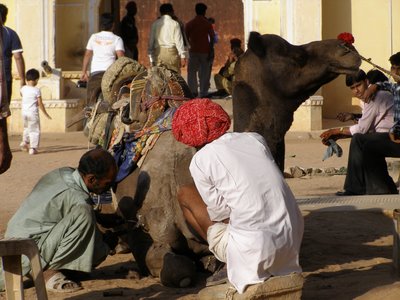Since then we've been back on the road, first stopping off in Varanasi on the Ganges. Our hotel overlooked Harischandra Ghat (a burning funeral spot) and so death became part of our daily ritual, along with the best cup of coffee in India and the most superior cheese cake in the world (both at Open Hand coffee and silk shop, owned, of course, by South Africans). We marvelled at the faithful not only bathing but also drinking the near-septic water of the holy river.
 Colourful queue into the Taj
Colourful queue into the Taj
And then we hit the All India Cliche Spot - the Taj Mahal in Agra. It is, unequivocally, the most beautiful building in the world - can anyone think of a contender that comes close?
Despite the thousands of tourists jostling for camera space, the ignominy of having to pose for one beautifully dressed family/giggling group of naughty boys/lecherous old men after the other and the potent whiff of a million sweaty feet (shoes have to be removed), we swoon for hours over this mausoleum to love. The sensuous, marble symmetry, the perfect proportion, the sheer romance of its raised position, the jewelled inlay work. It takes your breath away.
We blow the budget - and suffer great guilt - by spending sunset on the balcony of the Oberoi hotel, where I pay Rps 500 (more than GBP5) for a glass of wine while Coups has a lemon soda. To put it in perspective: our hotel room - obviously not the Oberoi - was a 'luxury splashout' at Rps 450.
The train that brought us from Varanasi to Agra (four hours late), is the same train that takes us to Jaipur, capital of Rajasthan, a few days later. We congratulate ourselves on our foresight not to get to Agra Fort station on time for the supposed 6.15am departure, but at 9am. Just as well, because the train eventually pulls in at 10.30.
 Jaighar Fort, near Jaipur. Showing the Coups in fine fettle
Jaighar Fort, near Jaipur. Showing the Coups in fine fettle
Jaipur surely wins the award for the Most Hassly Town in the Land. Every rickshaw driver, man, woman, child and goat in the street is a travel industry entrepreneur - whether it be through customised trips (every one has exactly the same customised trip), see my brother/cousin's shop, only look, baksheesh (I thought that was an Arabic word?), I help you/you help me, always accompanied by the Which country? refrain.
It's so draining to apologise for being bad tourists (we're not here to buy, just to walk around the streets and look at the buildings) and nobody accepts no for an answer.
 Of course not
Of course not
Story of the day:from the Times of IndiaNegligence cry over death at hospital
ANGRY protests rocked (no less) the premises of a local veterinary (yep, veterinary) hospital on Monday following the death of a cow (what else) allegedly due to medical negligence. An irate mob gheraoed (Indian press loves this word) the 'errant' doctor's chamber for (get this) nearly an hour on Monday - Sunday being a holiday (of course).
...followed by reams of waffle about the unfortunate demise of the poor cow, which, it transpires, received a diarrhoea injection instead of fertility treatment. And then this, surely the most pithy quote from an unlikely source:
Sukdeb Shaw, a milkman of Makrampur, alleged that the vets at the hospital were lazy and never examined their patients. "They read newspapers or chat with pharmacists while clerks turn into doctors."
 Hurrah for colonialism
Hurrah for colonialism
Or at least as far as the dissemination across the former colonies of Marmite is concerned. Thank you, Britain, for enabling me to buy the black gold in a small corner shop, guarded by a sleepy buffalo, in Varanasi and in the madness of Calcutta's New Market. And shame on Australia for daring to think it could do it better with its paltry, repeat-tried-but-failed offerings (Vegemite, Promite, even their own version of Marmite - all shite-mite).
Indian food continues to charm the pants off us (literally) - a cullinary extravaganza that reaches fulfilment every morning with butter toast, covered in our delicious Marmite, and a cup of hot, sweet masala chai. Life is indeed beautiful.

 Elim dune near Sesriem in the Namib Naukluft National Park
Elim dune near Sesriem in the Namib Naukluft National Park
 Camping spot at Sesriem
Camping spot at Sesriem


.jpg)
 Luderitz, on the coast. A million miles from anywhere
Luderitz, on the coast. A million miles from anywhere Fishriver Canyon near the border with South Africa. A gruelling 5-day, 80km trek which is closed to hikers in summer
Fishriver Canyon near the border with South Africa. A gruelling 5-day, 80km trek which is closed to hikers in summer Sunset over Khuri, in the Thar desert
Sunset over Khuri, in the Thar desert















 Jaighar Fort, near Jaipur. Showing the Coups in fine fettle
Jaighar Fort, near Jaipur. Showing the Coups in fine fettle Of course not
Of course not Hurrah for colonialism
Hurrah for colonialism









 One up to the Chinese - their obscene finger juts outs disrespectfully across the square from the Potala in Lhasa
One up to the Chinese - their obscene finger juts outs disrespectfully across the square from the Potala in Lhasa













